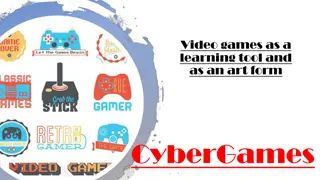Evolution of Arcade Games: From Mechanical to Digital (1870-1977)
Explore the fascinating journey of arcade games from mechanical and electro-mechanical devices in the 19th century to the birth of digital games in the mid-20th century. Witness the transition from coin-operated amusement machines to early digital arcade games and home consoles, shaping the gaming industry we know today.
Download Presentation

Please find below an Image/Link to download the presentation.
The content on the website is provided AS IS for your information and personal use only. It may not be sold, licensed, or shared on other websites without obtaining consent from the author. Download presentation by click this link. If you encounter any issues during the download, it is possible that the publisher has removed the file from their server.
E N D
Presentation Transcript
1. Mechanical and Electro-Mechanical Arcade Games (1870 1979)
Key Terms Automata Working Model Tester Viewer Trade Stimulator Parlor Penny Arcade Bagatelle
The Beginnings of Coin-Operated Amusement The second industrial revolution in the 1800s Early coin-operated entertainment devices (working models, testers, viewers) Machines in a variety of locations with appeal to different socio-economic classes
The Penny Arcade Sport-themed games introduce new concepts Driving games in the United States after World War II Pinball s development from a game of chance to a game of skill
2. The Birth of Digital Games: Research and Hacking (1945 1975)
Key Terms Computer Mini-Computer The Hacker Ethic Batch Processing Time-Sharing Network Wireframe 3D Persistent Game World
Games for Research Games for artificial intelligence research and scientific demonstration William Higinbotham s Tennis for Two
Games and the Hacker Ethic Increased access to computers The spread and modification of Spacewar! PLATO and early networked gaming The influence of Dungeons & Dragons
3. Early Digital Arcade Games and Home Consoles (1971 1977)
Key Terms Attract Mode Ball and Paddle Game Dedicated Console
Early Digital Arcade and Home Console Games Relationship to electro-mechanical and early computer games The Magnavox Odyssey and divided game spaces The founding of Atari and influence of Pong Dedicated consoles and the market flood of 1977
Key Terms Transistor Transistor Logic Microprocessor Shoot em up Climbing Game Laserdisc Vector Graphics Raster Graphics Multi-Genre Game
Golden Age Arcade Games Space Invaders and shoot em ups The addition of narrative to arcade games Donkey Kong and the climbing game The range of control schemes
5. Early Cartridge-Based Home Console Games (1976 1983)
Key Terms Sprite Venetian Blinds Bank Switching Easter Egg
Cartridge-Based Home Consoles The first console wars The emergence of third-party developers Adapting arcade games to the home New design concepts suited for the home (adventure and resource management) The North American console market crash of 1983 1984
6. Commercialized Home Computer Games (1977 1995)
Key Terms Microcomputer Assembly Language Open Architecture Design Optical Color Mixing Anti-Aliasing Open World Gameplay Rotoscoping GUI
Early Home Computer Games Adaption of games originating on PLATO and in university contexts to commercial software The continued influence of Dungeons & Dragons Flight and simulation games
Mice, GUIs, and Computer Games Changes in home computer hardware The effect of the mouse on interfaces and gameplay Accelerated gameplay with real-time strategy games
7. Japanese Arcade and Console Games (1983 1995)
Key Terms Pseudo-3D Pre-Rendered Visuals Beat em-up
Japanese Post-Golden Age Arcade Games Greater emphasis on visuals and sound Refinement and polish of existing forms Beat em up gameplay and Head-to-Head Fighting Games
Japanese Consoles and the Home Nintendo transition and dominance of the home market Nintendo s franchise establishment Sega s transition to the home and the second console war The proliferation of platforming gameplay
Key Terms Multimedia Haptic Feedback Virtual Reality First Person Shooter Shareware Raycasting Game Engine Mod/Total Conversion
CD-ROMs and Photorealism Re-emergence of laser discs in arcades Interactive film and puzzle games on CD-ROM
Real-Time 3D and Spatial Realism Early efforts in commercialized virtual reality Arcade-based vehicle simulators and 3D imagery Add-ons and enhancements for 3D on home consoles Combining 2D imagery with real-time 3D
9. Contemporary Games and Game Design (1996 present)
Key Terms Graphics Accelerator Scripted Sequences Streaming Texture Map/Color Map Shaders Bump Maps Set Pieces
3D Game Design in the Late 1990s Technological shifts New camera and control schemes across genres Cinematic perspectives in 3D games
3D Game Design in the 2000s Changes in the game industry Open world gameplay in the 2000s The emergence of casual and mobile games Digital distribution in the 2000s Realism in 3D surfaces Film-like gameplay The retro revival
10. Contemporary Independent Games (1996 present)
Key Terms Freeware Doujin Soft Creative Sandbox Narrative Exploration
Independent Games in the Early 2000s The Scratchware Manifesto Shareware, Freeware, and Flash games Alternative modes of funding and distribution Blurred lines between games and art
Independent Games in the Contemporary Online distribution of independent games Console platforms and independent games Reviving and reinterpreting earlier genres Expanding audiences and niche appeal Challenges in the independent games sector

























